Growing up, I always loved ordering spring roll vs egg roll whenever my family went out for Asian food. However, as I got older, I started to wonder: what’s the difference between these two roles?
Through personal experience, research, and taste testing, I’ve discovered the unique characteristics of both rolls. In this article, we’ll delve into the origins, wrapper, filling, flavor, health benefits, and cultural significance of spring rolls and egg rolls.
Join me in this delicious exploration of the ultimate showdown: the difference between egg roll and spring roll.
What is spring roll, and egg roll?
Spring rolls and egg rolls are two popular appetizers commonly found in Asian cuisine.
The origins of these rolls can be traced back to China, where they were traditionally eaten during the spring festival as a symbol of new beginnings. Over time, the rolls spread to other Asian countries and were adapted to local ingredients and cooking techniques.
Despite their distinct differences, many people are confused about the difference between spring roll and egg roll. This may be because some restaurants use the terms interchangeably or offer variations that blur the lines between the two.
However, by examining the wrapper, filling, texture, and cooking method of each roll, we can better understand their unique characteristics and appreciate them for their own distinct flavors.
What is a spring roll?
A spring roll consists of a thin, crispy wrapper filled with a variety of ingredients, such as vegetables, meat, seafood, and sometimes noodles. The wrapper is typically made from rice flour or wheat flour, which is rolled into thin sheets and then filled with the desired ingredients.
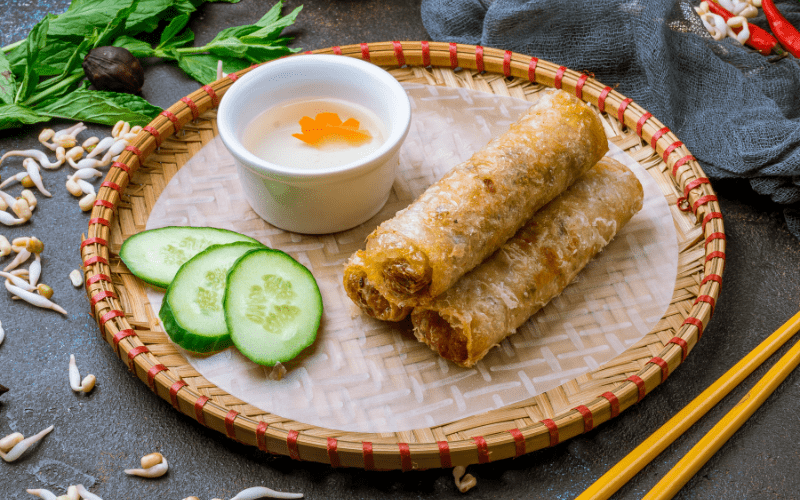
Traditional ingredients in spring rolls often include vegetables such as carrots, bean sprouts, and cabbage, as well as meats like shrimp, pork, or chicken. In some cases, spring rolls may also contain noodles such as vermicelli or glass noodles. The filling is often seasoned with spices and herbs like garlic, ginger, and cilantro to enhance the flavor.
There are several regional variations of spring rolls, including Vietnamese spring rolls, which often feature a combination of rice noodles, pork, and shrimp, wrapped in rice paper.
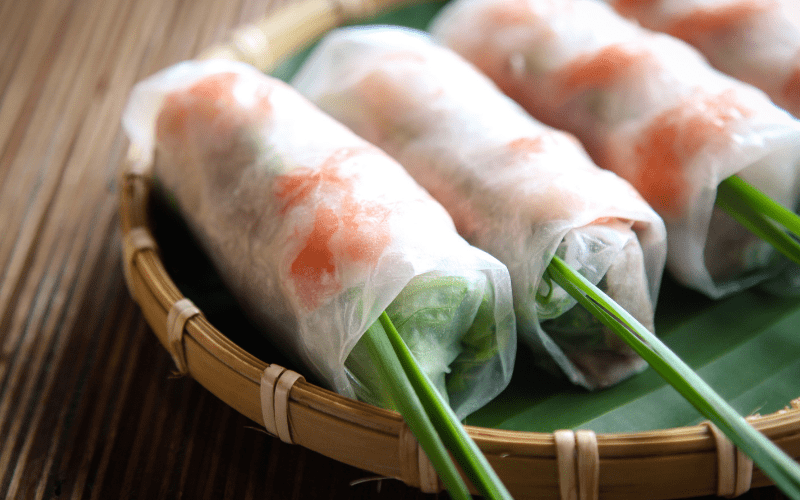
Thai spring rolls, on the other hand, may include a variety of tropical fruits and herbs, such as mango, basil, and mint. In China, spring rolls are often filled with vegetables and meats like pork, chicken, or beef, and are usually deep-fried until crispy.
What is an egg roll?
An egg roll features a thicker wrapper than a spring roll and is typically filled with a mixture of vegetables like cabbage and carrots, as well as meat such as pork or chicken. The wrapper is made of flour, water, and eggs, which gives it a slightly chewy texture and golden color. Or you can find green bean rice paper rolls made with wheat flour, water, vegetable oil, mung bean flavor and salt.
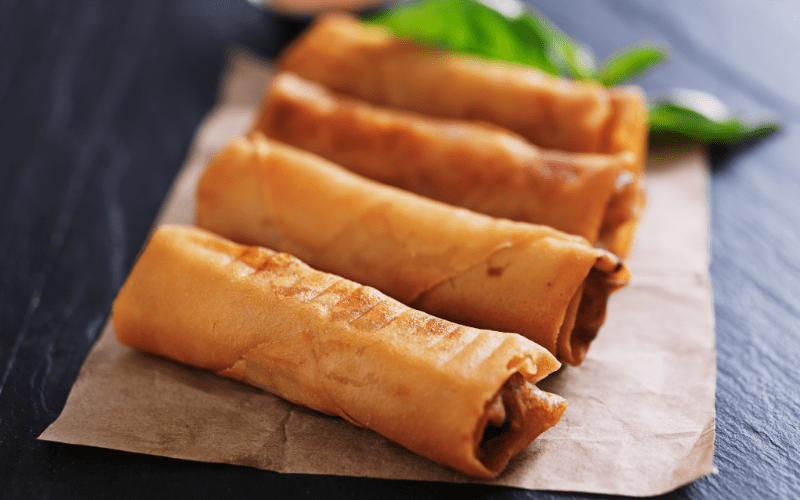
The origins of egg rolls are somewhat debated, but it is believed that they were created by Chinese immigrants in the United States in the early 20th century. They were likely adapted from the traditional spring rolls and were designed to appeal to American palates.
The filling of an egg roll typically includes shredded cabbage, carrots, and sometimes bean sprouts, along with meat such as pork, chicken, or shrimp. The filling is often seasoned with soy sauce, ginger, and garlic to enhance the flavor. Unlike spring rolls, egg rolls do not typically contain noodles.
There are several regional variations of egg rolls, including Chinese egg rolls, which are often larger and feature a thicker wrapper than American egg rolls.
In the Philippines, egg rolls are known as “lumpia” and may be filled with a variety of ingredients, such as ground pork, shrimp, and vegetables. In Vietnam, egg rolls are often called “cha gio” and are typically smaller and made with a rice paper wrapper.
What is the difference between egg rolls and spring rolls?
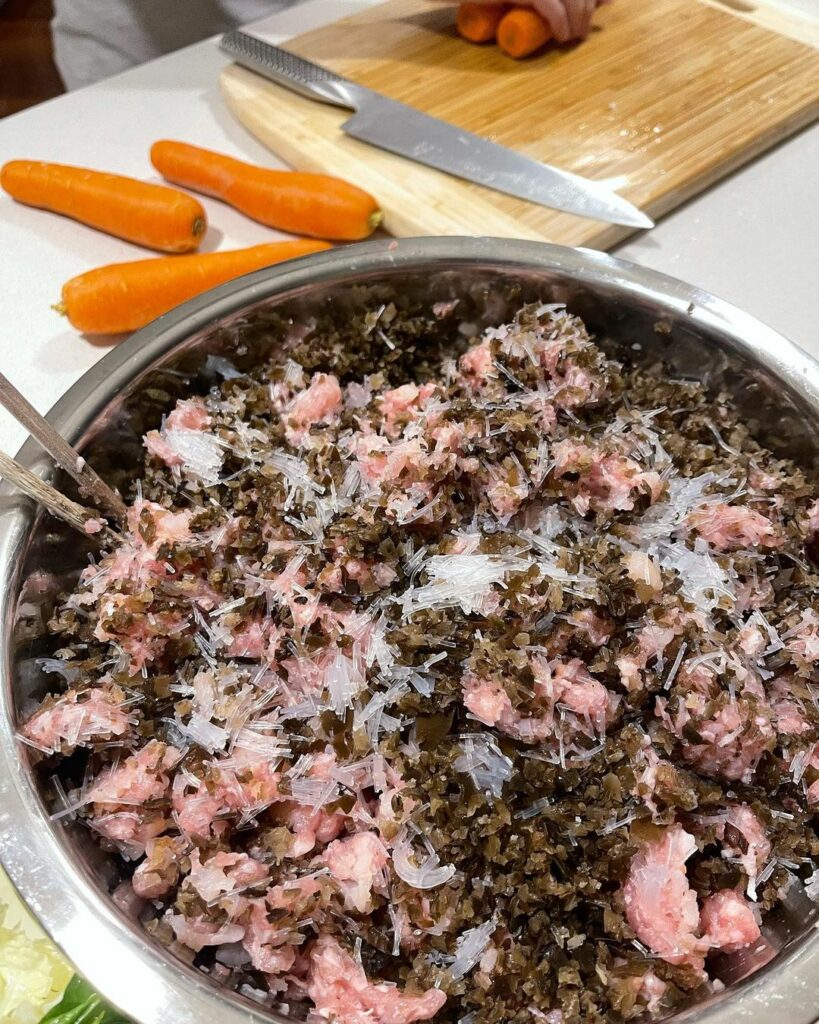
The difference between egg rolls and spring rolls can be found in several key areas.
| Spring roll | Egg roll | |
| Wrapper | Have a thin, crispy wrapper made from rice or wheat flour. | Have a thicker, chewier wrapper made from flour, water, and eggs. |
| Filling | Contain a wider range of ingredients, including noodles, shrimp, and other seafood. | Typically, contain cabbage and carrots, and are often accompanied by a meat filling like pork or chicken. |
| Texture | Have a crispy, delicate texture due to the thin wrapper. | Have a chewier texture due to the thicker wrapper. |
| Flavor | Typically, lighter and fresher, with a focus on the flavors of the vegetables and herbs used in the filling. | Tends to be heartier, with a savory taste that comes from the meat and cabbage filling. |
| Cooking method | It can be either deep-fried or baked to achieve a crispy exterior. | Often deep-fried until golden and crispy. |
Which is healthier spring roll or egg roll?
When it comes to health, there are some differences between spring rolls and egg rolls to consider.
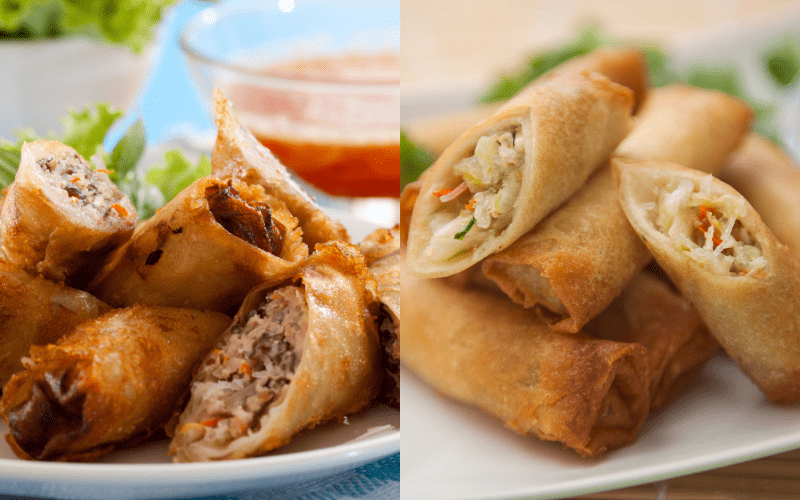
Spring rolls are generally considered the healthier option, as they typically contain fewer calories and less fat than egg rolls. This is because the wrapper is thinner and the filling usually contains more vegetables and lean proteins.
For example, a typical vegetable spring roll contains around 120–150 calories and 2–3 grams of fat, while a pork egg roll can contain up to 200 calories and 8–10 grams of fat.
However, it’s important to note that the nutritional content of both rolls can vary depending on the recipe and cooking method used. In terms of protein and carbohydrates, both rolls are fairly similar, with spring rolls usually containing slightly more protein and fewer carbohydrates than egg rolls.
Both spring rolls and egg rolls can also provide some health benefits, such as the vitamins and minerals found in the vegetables and lean proteins used in the fillings. However, they can also have drawbacks if they are deep-fried or loaded with high-calorie, high-fat ingredients.
Overall, if you are looking for a healthier option, spring rolls may be the way to go. But as with any food, moderation is key, and it’s important to consider the specific ingredients and cooking methods used when making your choice.
Best sauces to serve with spring rolls and egg rolls
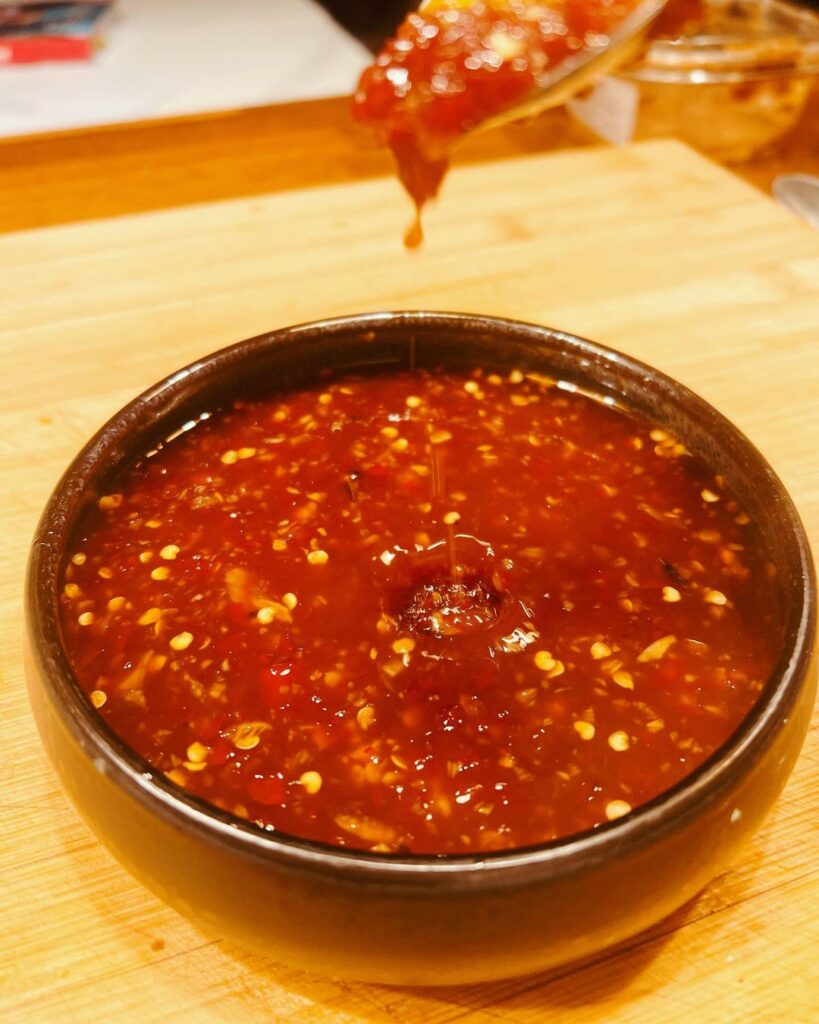
There are several sauces that pair well with both spring rolls and egg rolls, each with its own unique flavor profile.
- Sweet chili sauce is a popular choice, providing a sweet and tangy flavor that complements the savory filling of both rolls. Peanut sauce, on the other hand, is rich and creamy with a slightly nutty flavor that pairs well with the crunchiness of the rolls.
- Hoisin sauce is another popular option, offering a sweet and savory taste with a slightly thick and syrupy texture. It is often used in Chinese cuisine and pairs well with pork and chicken-based rolls.
- Soy sauce is a classic dipping sauce that is commonly served with both spring rolls and egg rolls. Its salty taste helps to enhance the flavor of the filling and the crispy texture of the rolls.
When it comes to choosing the best sauce to serve with your rolls, it ultimately comes down to personal preference. Some people prefer a sweeter sauce, while others enjoy a more savory or spicy option. It’s also important to consider the ingredients in the rolls when selecting a sauce to ensure that the flavors complement each other well.
Trying out different sauces and experimenting with combinations can be a fun and delicious way to discover the perfect match for your favorite rolls.
Where to find spring rolls and egg rolls?
Spring rolls and egg rolls can be found in a variety of places, including:
- Restaurants: Many Asian restaurants and fusion restaurants offer spring rolls and egg rolls as appetizers or as part of a meal. Some restaurants may specialize in certain types of rolls, such as Vietnamese or Chinese.
- Grocery stores: Many grocery stores carry frozen spring rolls and egg rolls that can be baked or fried at home. Some stores may also sell the ingredients to make your own rolls from scratch.
- Food trucks: Food trucks specializing in Asian cuisine may offer spring rolls and egg rolls as popular street food options. These trucks can often be found at food festivals, markets, and other outdoor events.
- Markets: Local markets and specialty stores may offer handmade or fresh rolls made by local chefs or vendors. These can provide a unique and fresh taste that can’t be found in frozen or pre-made rolls.
- Online: Many Asian food retailers offer spring rolls and egg rolls for purchase online. This can be a convenient option for those who may not have access to a local restaurant or grocery store that carries these items.
FAQs
Can I freeze leftover spring rolls or egg rolls?
Yes, you can freeze leftover spring rolls or egg rolls. To freeze, place the rolls in a single layer on a baking sheet and freeze for an hour.
Once the rolls are frozen, transfer them to a plastic bag or airtight container and store them in the freezer for up to three months. To reheat, preheat your oven to 375°F (190°C) and bake the frozen rolls for 15-20 minutes or until heated through.
Can I make vegetarian or vegan spring rolls or egg rolls?
Yes, you can make vegetarian or vegan spring rolls or egg rolls. Simply omit any meat or seafood and replace it with additional vegetables or plant-based proteins such as tofu or tempeh.
You can also use rice paper wrappers to make a vegan version of spring rolls, and substitute the egg in the wrapper of an egg roll with a vegan egg substitute or omit it altogether. Be sure to check the ingredients in your dipping sauces to ensure they are also vegan or vegetarian.
How do I prevent my spring rolls or egg rolls from getting soggy?
To prevent your spring rolls or egg rolls from getting soggy, it’s important to make sure the filling is not too wet or over-stuffed. Drain any excess liquid from the filling ingredients, and use a paper towel to pat them dry if necessary.
Additionally, avoid leaving the rolls out at room temperature for too long before frying or baking, as this can cause the wrapper to absorb moisture.
What types of wrappers are used for spring rolls and egg rolls?
For spring rolls, the most common types of wrappers used are rice paper wrappers, which are thin, translucent, and slightly sticky when wet. For egg rolls, the most common type of wrapper is made with wheat flour, water, and eggs, and is thicker and chewier than a spring roll wrapper.
However, there are other types of wrappers available for both spring rolls and egg rolls, such as tapioca starch wrappers or eggless egg roll wrappers made with water, flour, and cornstarch.
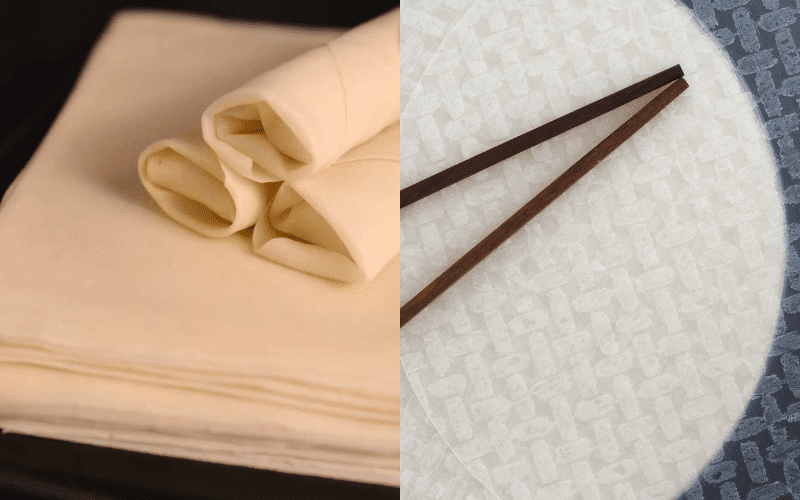
So it’s very nice to know which egg roll wrappers vs spring roll wrappers will suit your dish needs. For example, rice paper wrappers are often used for fresh spring rolls that are not fried, and whole wheat flour wrappers are commonly used for deep-fried egg rolls.
Are there gluten-free options for spring rolls and egg rolls?
Yes, there are gluten-free options available for spring rolls and egg rolls. Some manufacturers make wrappers from rice or tapioca starch instead of wheat flour, which is naturally gluten-free.
You can also make your own gluten-free wrappers using rice paper or corn tortillas. However, it’s important to check the ingredients of your filling and dipping sauce to ensure they are also gluten-free.
How long do spring rolls and egg rolls stay fresh?
The freshness of spring rolls and egg rolls can vary depending on how they are stored. If they are left at room temperature for an extended period, they can become soggy and lose their crispness.
To keep them fresh, store them in an airtight container or plastic bag in the refrigerator for up to three days. If you want to store them for longer, you can freeze them for up to three months.
Be sure to reheat them in the oven or fryer to regain their crispness before serving.
Can I bake spring rolls and egg rolls instead of frying them?
Yes, you can bake spring rolls and egg rolls instead of frying them for a healthier option. To bake, preheat your oven to 400°F (200°C) and place the rolls on a baking sheet lined with parchment paper.
Brush the rolls with a little bit of oil and bake for 15-20 minutes, or until the rolls are crispy and heated through.
Are spring rolls and egg rolls spicy?
The level of spiciness in spring rolls and egg rolls can vary depending on the recipe and ingredients used. Some recipes call for spicy ingredients such as chili paste or hot sauce, while others may not have any heat at all.
If you prefer your rolls to be spicier, you can add more of these ingredients or serve them with a spicy dipping sauce. If you prefer a milder flavor, simply omit or reduce the amount of spicy ingredients used.
How do I know when my spring rolls or egg rolls are done cooking?
To know when your spring rolls or egg rolls are done cooking, look for a golden brown color on the outside and a crispy texture. You can also check the internal temperature using a thermometer; it should read at least 165°F (74°C) for food safety.
Keep in mind that the cooking time may vary depending on the size of the rolls and the cooking method used.
Can I use pre-packaged coleslaw mix in my egg rolls?
Yes, you can use pre-packaged coleslaw mix in your egg rolls. Simply mix the coleslaw with other desired ingredients, such as cooked chicken or pork, and wrap it in the egg roll wrappers.
The coleslaw can add a crunchy texture and fresh flavor to the filling. However, be sure to drain any excess liquid from the coleslaw before adding it to the filling to prevent your rolls from getting too wet.
Conclusion
Ultimately, the difference between spring roll vs egg roll lies in their wrapper, filling, texture, flavor, and cultural origins. While both rolls are delicious, they offer unique characteristics that make them distinct from one another.
When it comes to health, spring rolls are generally considered the healthier option due to their thinner wrapper and use of more vegetables and lean proteins. However, the nutritional content of both rolls can vary depending on the recipe and cooking method used.
When it comes to serving these rolls, there are several sauce options to choose from, each providing a unique flavor that can complement the rolls well.
Whether you prefer the crispy, delicate texture of spring rolls or the chewy, hearty texture of egg rolls, both offer a delicious appetizer that can be found in restaurants, grocery stores, food trucks, markets, and online retailers.
In the end, the choice between spring rolls and egg rolls comes down to personal preference, occasion, and accessibility. Whichever you choose, one thing is for certain: these Asian appetizers will always be a crowd-pleaser that never fails to satisfy.
